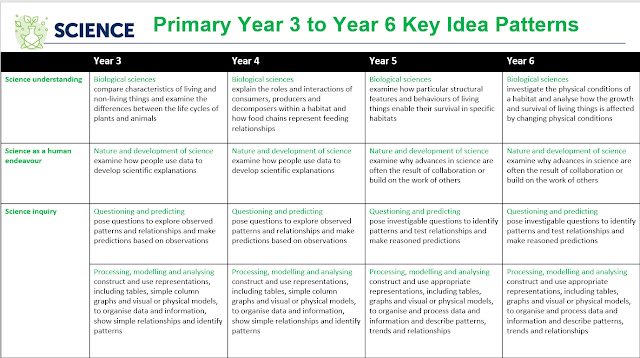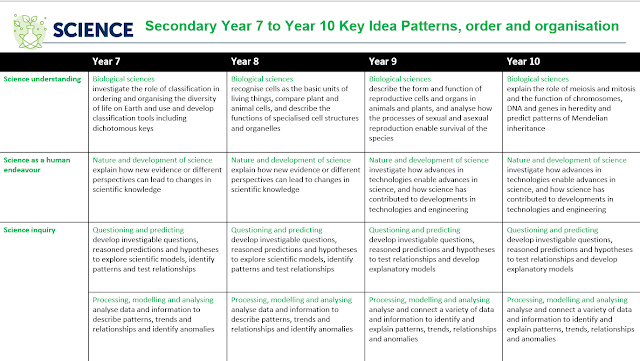Australian Curriculum V9.0 Key Ideas Part 1
1. Patterns,order and organisation
What’s important is that the Key ideas and the understanding
that sits beneath them are equally relevant to students who want to go on and
work in science as it is for those who want to live with an appreciation of
science. They are incredibly unifying and equitable.
What they are:
The key ideas distil down scientific knowledge into six
guiding principles that we can use to explain a diversity of scientific phenomena.
The key ideas are designed to :
• provide
lenses by which we can make sense of the world,
• support
teachers and students to make connections across the 3 strands of science,
• support
the coherence of science understanding within and across year levels throughout
Reception to Year 10.
What they are not:
Whilst big ideas help to frame the ultimate goals of science
education, it’s important to recognise that big ideas cannot be taught
directly.
If we try to devise activities that teach big ideas
directly, we end up with some superficial activity.
We don’t teach students directly about each key idea but
provide opportunities for them to learn how there are key ideas underpinning
the science concepts found within each strand ->sub strand -> content
description
Key Idea: Patterns, order and organisation
• An
important aspect of science is recognising patterns in the world around us and ordering
and organising phenomena at different scales.
• As
students progress from Foundation to Year 10, they build skills and
understanding that will help them to observe and describe patterns at different
scales and develop and use classifications to organise events and phenomena and
make predictions.
• As
students progress through the primary years, they become more proficient in identifying
and describing the relationships that underpin patterns, including cause and
effect.
• Students
increasingly recognise that scale plays an important role in the observation of
patterns; some patterns may only be evident at certain time and spatial scales.
What do patterns have to do with science?
·
Children naturally develop the skill of pattern
recognition but perfecting that skill requires explicit teaching for students
to understand how patterns connect mathematics and science.
·
Teachers need to provide opportunities for
students to learn how to detect patterns, how to understand patterns, how to
analyse patterns, how to use patterns and how to find new patterns.
Why teach science through the Key Idea Patterns?
•
Patterns support the development of scientific
explanations, theories, and models.
•
To support students in understanding core concepts,
patterns need to be visible and explicit.
•
To engage students in scientists’ science, we
need to engage students in using patterns as part of the scientific practices.
•
Noting patterns as a starting point for
asking scientific questions,
•
Using statistics to determine the
significance of mathematical patterns
•
Mathematical representations are needed to
recognise some patterns
•
Empirical evidence is needed to identify patterns
•
Basing arguments “on inductive
generalisations of existing patterns”



No comments:
Post a Comment